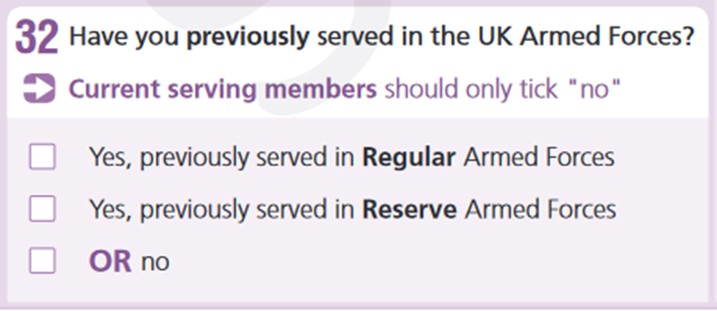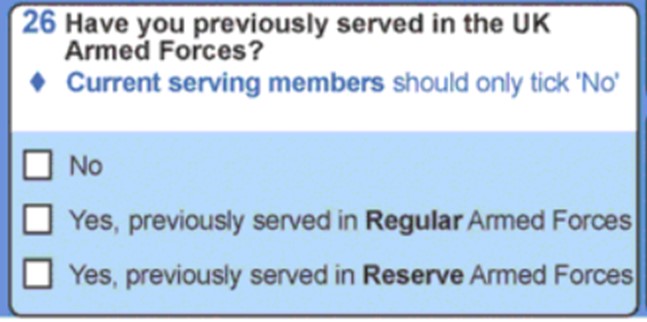Veteran status
Veteran status
Oliver Duke-Williams
Introduction
UK Censuses have long asked questions about occupation, including the last job for those not currently working. The 2021/22 round has seen the introduction of specific questions about previous service in the UK Armed Forces, in order to help better understand the circumstances of and address the needs of veterans, and for the Government to be able to meet its obligations under the Armed Forces Covenant. Unlike the other new questions on sexual orientation and gender identity, this question was not an optional one.
What questions were asked?
In England and Wales and in Scotland, the same question was asked (the only difference being in the order of the response categories. People completing the census were asked “Have you previously served in the UK Armed Forces?” with responses being ‘yes’ (with both regular and reserve forces as tick boxes), or ‘no’.
The census questions refer to ‘the UK Armed Forces’, which include the Royal Navy, the Royal Marines, the British Army and the Royal Air Force. The questions have generally been referred to as ‘the veterans question(s)’; the Ministry of Defence has a separate and specific (but overlapping) definition of ‘veteran’ as “anyone who has served for at least one day in Her Majesty’s Armed Forces (Regular or Reserve) or Merchant Mariners who have seen duty on legally defined military operations.”).
|
 |
 |
In Northern Ireland however, there was no such question on the form, following analysis of the 2019 Rehearsal, and acceptability concerns raised in consultation with veterans. Instead, administrative data from the Ministry of Defence are to be linked to the census and used to report information about veterans living in Northern Ireland.
How will data be produced?
We expect tabulations to be produced of veterans by a range of other variables including age, health and disability statuses, occupation and economic status, and also tabulations of numbers of households containing at least one veteran. Current plans suggest that tables will be of all veterans (both regular and reservist) but that there will also be a table indicating numbers of veterans who were regular, or reserve, or both.
How does this compare with previous censuses?
There have been no previous questions about veteran status. England and Wales, Scotland and Northern Ireland all have longitudinal data sets, in which it is possible to tabulate and analyse records of persons who had indicated at previous censuses that their current occupation at the time was as a member of the Armed Forces, although it has been recognised that current members of the armed forces are one of a number of groups that have been subject to underenumeration.
How will different parts of the UK compare?
Data for England and Wales and Scotland should be comparable, as the same question wording was used, and furthermore the question was specifically about previous service. The results are therefore less likely to be affected by the changed census date in Scotland, or by short or longer term changes in circumstance due to the COVID-19 pandemic than is the case for some other census questions.
As described above, the data for Northern Ireland are taken from administrative data. The same source (the MoD Service Leavers Database) was considered for England and Wales and for Scotland, but was considered to be problematic in that it did not include those who had left service prior to 1975. The data for Northern Ireland may therefore be difficult to compare directly with those for the rest of the UK. Concerns over disclosure may also mean that there are differing levels of spatial and attribute detail for results released in different parts of the UK.
